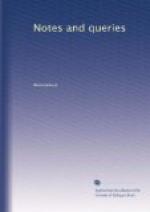NORTHMAN.
Tureen—How and whence is the term “tureen” derived?—and when was it introduced?
“At the top there was tripe in a swinging tureen.”
Goldsmith’s Haunch of Venison.
G.W.
Military Execution.—I am very anxious to be referred to the authority for the following anecdote, and remark made on it:—
“Some officer,
or state prisoner, on being led out to be shot,
refused either to listen
to a confessor, or to cover his eyes with
a handkerchief.”
The remark was, that “he refused a bandage for either mind or body.” It smacks somewhat of Voltaire.
MELANION.
Change of Name.—If, as it appears by a recent decision, based, perhaps, on a former one by Lord Tenterden, that a man may alter his name {247} as he pleases without the royal license, I wish to know what then, is the use of the royal license?
B.
The Symbolism of the Fir-Cone. What does the “fir-cone” in the Ninevite sculptures mean? Layard does not explain it. Is it there as the emblem of fecundity, as the pomegranate of Persia and Syria? Has it altogether the same character as the latter fruit? Then—was it carried into Hindostan via Cashmir? When? By the first wave of population which broke through the passes of the Parapamisus?
B.C.
Kentish Ballad.—When I was a boy, I can remember hearing a song sung in Kent, in praise of that country, which I never could find in print, and of which I am now glad to recollect the following stanza:—
“When Harold was invaded,
And falling lost his crown,
And Norman William waded
Through gore to pull him down;
When countries round
With fear profound,
To help their sad condition,
And lands to save,
Base homage gave,
Bold Kent made no submission.”
Can any reader furnish the remainder, and state who is the author?
F.B.
Curious Monumental Brass.—I have a rubbing of a Brass, presenting some peculiarities which have hitherto puzzled me, but which probably some of your more experienced correspondents can clear up.
The Brass, from which the rubbing is taken (and which was formerly in the Abbey church of St. Albans, but when I saw it was detached and lying at the Rectory), is broken off a little below the waist; it represents an abbot, or bishop, clad in an ornamented chasuble, tunic, stole, and alb, with a maniple and pastoral staff. So far all is plain; but at the back (i.e. on the surface hidden when the Brass lay upon the floor) is engraved a dog with a collar and bells, apparently as carefully executed as any other part. Can you tell me the meaning of this? I can find no mention of the subject either in Boutell or any other authority. The fragment is about 18 inches long, and the dog about 6, more or less.




